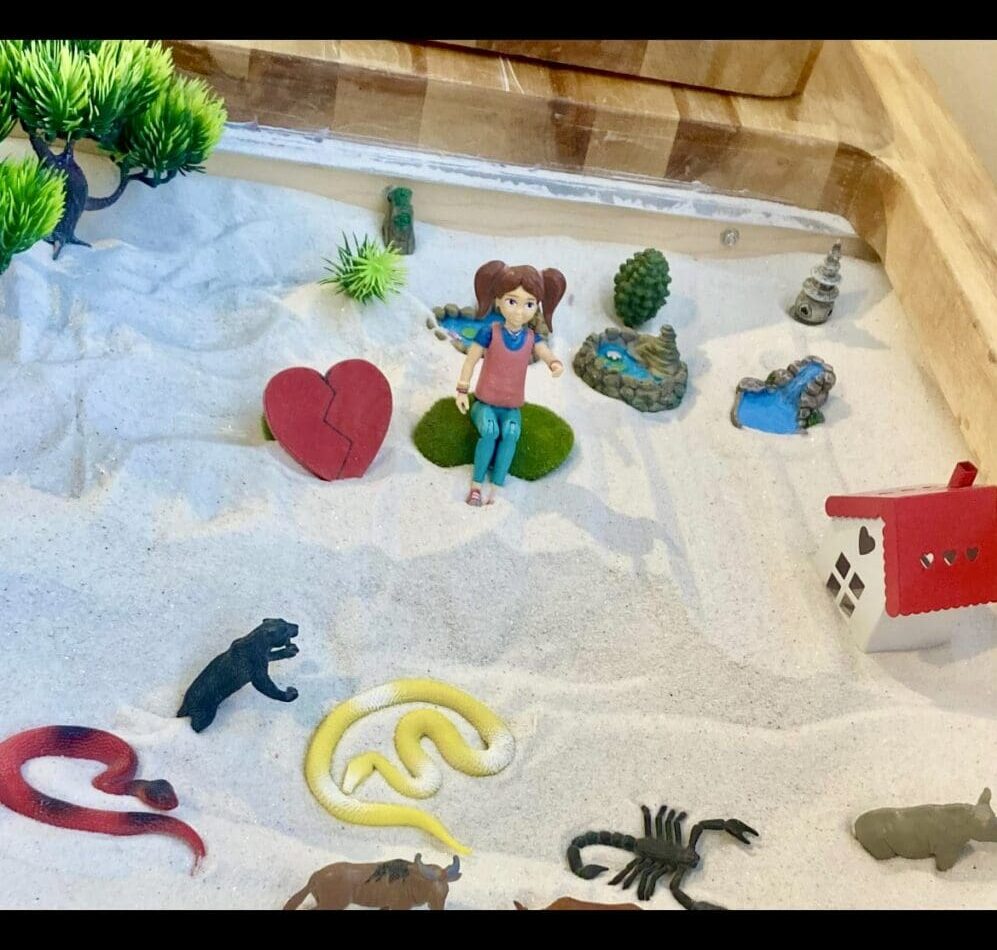How Sand Tray Therapy Helps Children Express Their Inner World

Using Symbol and Play to Reveal Emotional Truths
Explore how sand tray therapy helps children express boundaries, trauma, and inner resilience. Learn how licensed art therapist Beth Patane uses this powerful tool in child therapy sessions.
Why Sand Tray Therapy Is So Powerful in Child and Teen Psychotherapy
As a licensed art therapist, one of the most powerful tools in my practice is the sand tray—a simple yet profoundly expressive therapeutic technique. Sand tray therapy allows children to externalize thoughts and emotions they often can’t put into words, creating scenes with miniatures in a tactile, open-ended environment.
This approach is particularly effective for neurodivergent children, those with anxiety, and children working through trauma or family challenges.
What One Sand Tray Can Reveal
In a recent session, a young client used the sand tray to create a highly symbolic image: a line of scorpions and snakes separating her and her “heart” from the people on the other side of the tray.
This setup spoke volumes.
Without saying a word, this child had clearly expressed:
- A boundary between herself and others
- A sense of emotional danger or mistrust
- The importance of protecting her heart
This is the kind of meaning-making that sand tray therapy excels at—it taps into a child’s unconscious and symbolic language long before they may be able to express it verbally.
Play as a Pathway to Insight
In art and play therapy, symbolic play comes before conscious understanding. Children don’t always realize the full meaning of their creations right away—but over time, through gentle exploration, they begin to connect their external world to their internal experiences.
The sand tray offers a safe space for reflection and self-expression without pressure.
Coping Skills and Inner Strength in the Sand
This same client also placed essential resources on her side of the boundary:
- A house
- Water
- Shade in the desert
These aren’t random objects. They reflect her coping skills, inner resourcefulness, and ability to care for herself emotionally—even in a challenging emotional “climate.”
In child therapy, these visual metaphors are invaluable. They guide our work together and help the child begin to see themselves as capable, strong, and worthy of safety.
Why I Use Sand Tray in My Art Therapy Practice
Sand tray therapy is particularly useful for:
- Children who are nonverbal or reluctant to talk
- Clients with trauma, anxiety, or attachment wounds
- Neurodivergent youth who benefit from visual and sensory-based approaches
- Kids experiencing family stress, school issues, or emotional overwhelm
By using miniatures, textures, and space, children construct their world, and in doing so, begin to heal it.
📍 Located in Westchester, NY
I specialize in art therapy and sand tray therapy for children, teens, and neurodivergent clients. My sessions are trauma-informed, developmentally appropriate, and designed to support emotional expression in creative, nonverbal ways.
💻 Learn more or book a consultation at: bethpatanearttherapist.com
- sand tray therapy Westchester
- art therapy for children
- play therapy techniques
- trauma therapy for kids
- nonverbal therapy for children
- creative therapy for anxiety
- child therapist Westchester NY
- symbolic play in therapy
- boundaries and emotional safety in children
- coping skills through play therapy
#SandTrayTherapy #ChildTherapy #ArtTherapyForKids #PlayTherapyWorks #BethPataneArtTherapist #WestchesterTherapist #CreativeTherapy #NonverbalHealing #TraumaInformedCare #NeurodivergentSupport
